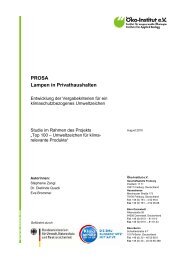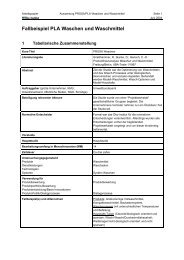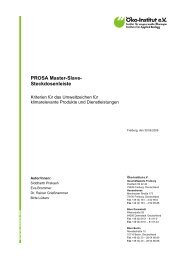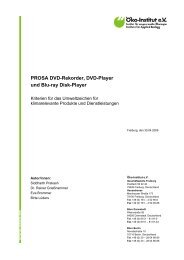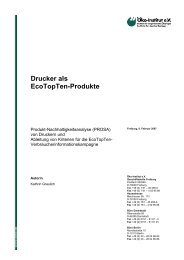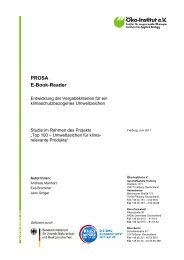PROSA – Product Sustainability Assessment - PROSA - Produkt ...
PROSA – Product Sustainability Assessment - PROSA - Produkt ...
PROSA – Product Sustainability Assessment - PROSA - Produkt ...
Sie wollen auch ein ePaper? Erhöhen Sie die Reichweite Ihrer Titel.
YUMPU macht aus Druck-PDFs automatisch weboptimierte ePaper, die Google liebt.
<strong>PROSA</strong> <strong>Product</strong> <strong>Sustainability</strong> <strong>Assessment</strong><br />
10.7.2 Classification systems for social indicators<br />
The Taskforce intensively discussed the topic of classification systems for social indicators.<br />
The group widely agreed upon the need of such a system. Currently there are two proposed<br />
classification systems, which are complementary and not contrary.<br />
In his presentation on “a consistent structure for modelling the social impact chains from<br />
inventory results to damage categories”, Bo Weidema proposed to categorize the social<br />
indicators 45 and offered a set of nine categories (see below). The taskforce debated the<br />
proposal in general and the categories in detail 46 . Most of the members of the Taskforce<br />
proposed an stakeholder approach. After an intensive discussion the Taskforce agreed with<br />
the following procedure 47 : In the phase of scope and analysis one should choose an<br />
stakeholder approach and according to this classify the indicators (comparable to GRI). In<br />
the phase of evaluation one can also arrange the social indicators in impact categories. It<br />
has been proposed to replace impact categories by "protection areas", but this name could<br />
lead to misunderstanding as the environmental LCA defines protection areas differently. The<br />
resulting list of indicators is classified in the first column after stakeholder groups, in the<br />
second column after impact areas. One impact category can be related to several<br />
stakeholder categories, one stakeholder category can be affected by different impact<br />
categories.<br />
10.7.2.1 The stakeholder approach for indicator-classification<br />
The purpose of the classification along stakeholder groups is to make sure that the Social<br />
LCA experts are matching the goal and scope and are assessing the bulk of the situation.<br />
For practical reasons and following the common practice the stakeholder categories were<br />
defined. Stakeholders will vary not only from one study to the other but also within each step<br />
of the value-chain. Efforts will have to be made while conducting a Social LCA to support<br />
stakeholders in finding and defining indicators adapted to their context and understanding.<br />
Looking at the complete life-cycle of a product, the Social LCA assesses social impacts of all<br />
its life-cycle steps from cradle to grave. These are related to resource extraction, processing,<br />
transport, manufacturing, assembly, marketing, sale, use, recycling, disposal and others as<br />
found during the construction of the process tree. Each of these steps can be associated with<br />
geographic locations, where one or more of these steps are carried out (mines, factories,<br />
roads, rails, harbours, shops, offices, recycling-firms, disposal-sites…). At each of these<br />
45<br />
46<br />
47<br />
Weidema, B.: A consistent structure for modelling the social impact chains from inventory results to damage<br />
categories. Presentation & Document 2005<br />
Rainer Griesshammer, Andreas Manhart, Louise Dreyer and Anna Flysjö, "Developing a Set of Indicators for<br />
a Social LCA", November 2005<br />
Minutes of the Taskforce Meeting, Brussels, 11. and 11. November 2005; TOP 4, question 2<br />
153



